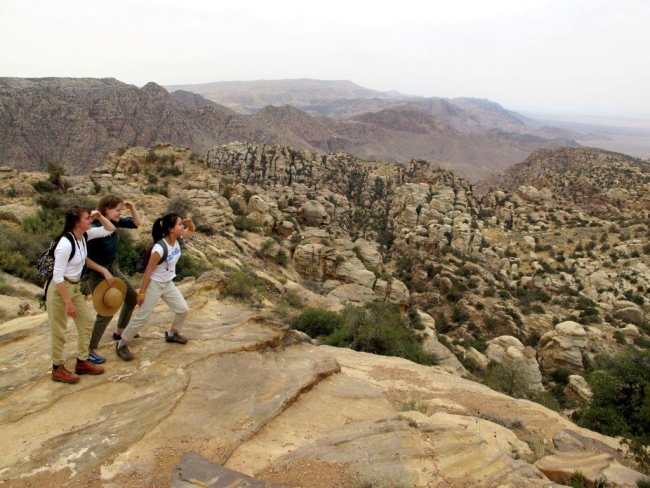You have /5 articles left.
Sign up for a free account or log in.

A snapshot from Columbia's Summer Ecosystem Experiences for Undergraduates (SEE-U) program in Jordan.
Columbia University
In five years, Columbia University has created a network of eight global centers: in Amman, Beijing, Istanbul, Mumbai, Nairobi, Paris, Rio de Janeiro and Santiago.
“Even though some units of the university might have had international operations around the world, and even though we have had study abroad programs forever and we have had faculty who have engaged in collaborations around the world, a couple of things were missing,” said Safwan M. Masri, Columbia’s executive vice president for global centers and global development and director of the global center in Amman.
“No. 1 was a concerted strategic effort to facilitate and support the engagement in a structured manner around the world. And No. 2 was a global context for engaging. It’s one thing to engage in East Asia, and to understand and study East Asia as East Asia, and it’s another thing to look at certain issues in East Asia and put them in a global context and be able to do comparative research. So the global centers came about as a result of that realization and out of a vision to create outposts that facilitate and promote the engagement of our faculty and students around the world,” Masri said.
More in This Package
- Numerous universities are bucking the branch campus trend, at least for now. Read more.
- Together, U. of Michigan and Shanghai Jiao Tong U. run innovative joint institute. Read more.
Shantanu Lal, an associate professor of dentistry, received $25,000 in funding last year to plan a collaboration in “teledentistry” with the University of Nairobi’s dental school. The two-part project involves screening for oral signs of AIDS progression in HIV-infected orphans as well as screening for signs of oral cancers in remote villages. In the latter case, the idea, Lal said, is that a midwife serving a rural village could put a $70 camera in a patient’s mouth and dentists in Nairobi and New York would receive the images and flag suspicious cases from afar. The Nairobi dental school would then follow up with those patients in person through its outreach program.
Lal is now applying for another grant to get the project off the ground. “To be honest with you I would have never embarked on this project had it not been for this initiative by the president of the university: had he not asked for a request for proposals and had the global centers not been there, this would not have happened,” said Lal, who relied on staff at Columbia’s global center in Nairobi to help him make high-level contacts with Kenya’s health ministry and the University of Nairobi’s Dental School to help him navigate the customs and culture.
“That was hugely helpful for someone who’s never been to Kenya before,” Lal said.
Similarly, Jenna M. Lawrence, an ecologist and evolutionary biologist, was able to rely on the Amman center’s staff to take care of the logistics on a summer study abroad course she’s taught in Jordan for three summers now (this summer will be her fourth). She’d previously taught a version of the course, known as SEE-U, or Summer Ecosystem Experiences for Undergraduates, in the Dominican Republic, but when she started teaching the course in Jordan she spoke no Arabic and wasn’t especially familiar with the country, having visited only once, on a fact-finding trip to scope out the feasibility of offering the course there and to visit potential field sites. The course is an introduction to field ecology that primarily attracts non-science majors.
“Basically the global center just took care of everything, took care of all the logistics, made all the contacts for us, and provided a logistics person with us at every step in the way who could speak in Arabic,” Lawrence said. “It was wonderful. I could just focus on the academics.”
Another project taking advantage of the Global Centers is the Women Creating Change project, which involves a series of multiyear working groups on topics like “Gender and the Global Slum” and “Gender, Religion and Law in Muslim Societies.”
“It’s not a one-off kind of conference model, but they’re long-term collaborations that begin with a working group here in New York,” said Marianne Hirsch, a professor of comparative literature at Columbia. “We begin by meeting and working together and defining problems and issues and engaging in collaborative work with colleagues in some of the regions where global centers are located.”
Hirsch said the working group she’s most involved with, “Women Mobilizing Memory,” grew out of a trip she took to speak at the opening of Columbia’s global center in Chile. Using the opportunity to connect with colleagues she’d previously worked with, they visited memory sites and met with survivors who had been jailed and tortured during the Augusto Pinochet regime: “I realized what an incredible place that would be to study. The conversation started that way, we had a working group meeting in Santiago in December, and now our next meeting is in Istanbul, also facilitated by the global centers, in September.”
“It’s really about creating a network in these different parts of the world," Hirsch said.




